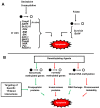DNA methylation and apoptosis resistance in cancer cells
- PMID: 24709797
- PMCID: PMC3972670
- DOI: 10.3390/cells2030545
DNA methylation and apoptosis resistance in cancer cells
Abstract
Apoptosis is a cell death programme primordial to cellular homeostasis efficiency. This normal cell suicide program is the result of the activation of a cascade of events in response to death stimuli. Apoptosis occurs in normal cells to maintain a balance between cell proliferation and cell death. A deregulation of this balance due to modifications in the apoptosic pathway leads to different human diseases including cancers. Apoptosis resistance is one of the most important hallmarks of cancer and some new therapeutical strategies focus on inducing cell death in cancer cells. Nevertheless, cancer cells are resistant to treatment inducing cell death because of different mechanisms, such as DNA mutations in gene coding for pro-apoptotic proteins, increased expression of anti-apoptotic proteins and/or pro-survival signals, or pro-apoptic gene silencing mediated by DNA hypermethylation. In this context, aberrant DNA methylation patterns, hypermethylation and hypomethylation of gene coding for proteins implicated in apoptotic pathways are possible causes of cancer cell resistance. This review highlights the role of DNA methylation of apoptosis-related genes in cancer cell resistance.
Figures



Similar articles
-
DNA methylation and apoptosis.Mol Immunol. 2006 Apr;43(11):1729-40. doi: 10.1016/j.molimm.2005.11.010. Epub 2006 Feb 28. Mol Immunol. 2006. PMID: 16500705 Review.
-
Investigation of DNA damage response and apoptotic gene methylation pattern in sporadic breast tumors using high throughput quantitative DNA methylation analysis technology.Mol Cancer. 2010 Nov 23;9:303. doi: 10.1186/1476-4598-9-303. Mol Cancer. 2010. PMID: 21092294 Free PMC article.
-
Aberrant methylation and silencing of ARHI, an imprinted tumor suppressor gene in which the function is lost in breast cancers.Cancer Res. 2003 Jul 15;63(14):4174-80. Cancer Res. 2003. PMID: 12874023
-
Physician Education: Apoptosis.Oncologist. 1996;1(6):399-401. Oncologist. 1996. PMID: 10388021
-
Pathophysiological mechanisms of death resistance in colorectal carcinoma.World J Gastroenterol. 2015 Nov 7;21(41):11777-92. doi: 10.3748/wjg.v21.i41.11777. World J Gastroenterol. 2015. PMID: 26557002 Free PMC article. Review.
Cited by
-
Synergistic Effect and Molecular Mechanisms of Traditional Chinese Medicine on Regulating Tumor Microenvironment and Cancer Cells.Biomed Res Int. 2016;2016:1490738. doi: 10.1155/2016/1490738. Epub 2016 Mar 2. Biomed Res Int. 2016. PMID: 27042656 Free PMC article. Review.
-
Aberrant expression of miR-21, miR-376c and miR-145 and their target host genes in Merkel cell polyomavirus-positive non-small cell lung cancer.Oncotarget. 2016 Aug 11;8(68):112371-112383. doi: 10.18632/oncotarget.11222. eCollection 2017 Dec 22. Oncotarget. 2016. PMID: 29348831 Free PMC article.
-
Restoration of DAP Kinase Tumor Suppressor Function: A Therapeutic Strategy to Selectively Induce Apoptosis in Cancer Cells Using Immunokinase Fusion Proteins.Biomedicines. 2017 Oct 4;5(4):59. doi: 10.3390/biomedicines5040059. Biomedicines. 2017. PMID: 28976934 Free PMC article. Review.
-
Aberrant DNA methylation as a key modulator of cell death pathways: insights into cancer progression and other diseases.Funct Integr Genomics. 2025 Mar 1;25(1):50. doi: 10.1007/s10142-025-01552-x. Funct Integr Genomics. 2025. PMID: 40024973 Review.
-
Environmental Implication of Herbicide Use.Molecules. 2024 Dec 18;29(24):5965. doi: 10.3390/molecules29245965. Molecules. 2024. PMID: 39770054 Free PMC article. Review.
References
-
- Hanahan D., Weinberg R.A. The hallmarks of cancer. Cell. 2000;100:57–70. - PubMed
LinkOut - more resources
Full Text Sources
Other Literature Sources

